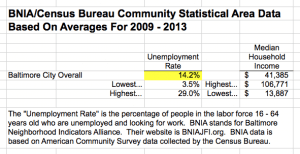 If you’re familiar with our work, you’ve heard us say or write the sentence, “Baltimore is a city in crisis.” We’re not kidding. We’re not just saying it for dramatic effect. It’s a fact. And why do we keep saying it? Because we’re concerned that our current city government and many candidates running for Mayor or Council don’t have an appropriate sense of urgency.
If you’re familiar with our work, you’ve heard us say or write the sentence, “Baltimore is a city in crisis.” We’re not kidding. We’re not just saying it for dramatic effect. It’s a fact. And why do we keep saying it? Because we’re concerned that our current city government and many candidates running for Mayor or Council don’t have an appropriate sense of urgency.
When we talk about the importance of jobs creation, it’s not casual, academic conversation. Not even close. From our point of view, the city has just arrived at the emergency room in very bad shape. Some would say, in critical condition. Baltimore is hemorrhaging, hanging on by a thread. It’s just that we’ve been this way for so long that many people, including our elected officials, have gotten used to it and are taking it for granted. And the infusions of blood we need to save our great city? Those are the jobs we keep talking about.
One of the reasons our elected officials and candidates – and voters too – don’t share our sense of urgency is numbers, the data we see every day, but most people don’t. Take a look, for example, at the PDF below. Just click on the link to see it. On the right side of the spreadsheet are Maryland LAUS (Local Area Unemployment Statistics) unemployment rates. Over the 5 years 2009 through 2013, Baltimore City had an average unemployment rate of 10.5%. That’s horrible. According to these data, more than 1 out of every 10 people who want to work and are looking for employment can’t find a job.
Community Statistical Area Unemployment Rates
But then it’s worse than that. Much worse. Look at the data on the left side of the spreadsheet that is from the BNIA (Baltimore Neighborhood Indicators Alliance) and is based on the Census Bureau’s American Community Survey. Their methodology allows them to take into account people who want to work, but have given up looking. These are people the LAUS data do not include which is why the BNIA unemployment rates are so much higher. 14.2% for the city overall. More than 14 out of every 100 people who want to work can’t find jobs.
But then it’s even worse than that, isn’t it, when you look at unemployment rates and median household income numbers for the city’s 55 “Community Statistical Areas.” The CSAs are sorted in descending order by unemployment rates. By “median” household income we mean that half the households are making less than the annual dollar gross income numbers shown in the table.
Sitting down? Maybe you should be. Of the 55 CSAs, 28 have unemployment rates in excess of the city’s overall average 14.2%. 14 have unemployment rates in excess of 20%. One in 5 of the people in these communities who want to work can’t find jobs. Five communities have unemployment rates – long-term average rates over the 5 years from 2009 through 2013 – in excess of 25%. One out of every 4 people who want to work can’t find a job.
Now look at the median household income numbers. Half of the households in any given neighborhood are making less than those annual income numbers. Think about all the people who are working, who aren’t technically unemployed, but who aren’t earning a living wage – who are among the 25% of our city living below the federal government’s poverty level.
So there you have it, voters, elected officials and candidates, if you’re paying attention. Look at those CSA unemployment rates and tell me – better yet, tell the families who make up those numbers – that Baltimore isn’t a city in crisis. Tell them, go head, tell them to their faces that jobs creation shouldn’t be a life and death emergency priority of our city government.
ATTENTION VOTERS: We have a saying around Baltimore Rising. “Big problems require big solutions.” What’s a “big solution”? You’ll know it when you hear it. It’s a solution that that solves a really big problem.
If a given candidate isn’t promising and offering a reasonable plan for economic recovery that virtually eliminates unemployment in Baltimore during the next 4 to 8 years tops, don’t even think about voting for her or him. Because that candidate doesn’t get it and isn’t worthy of your consideration.

